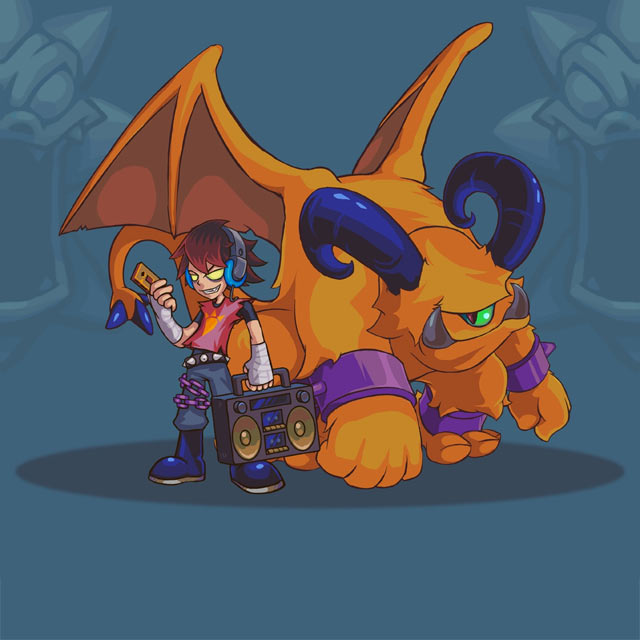
 One game left me jazzed at E3 2010 — Monster Tale. Yes, a Nintendo DS title (not 3DS) from startup developer DreamRift excited me more than Donkey Kong Country Returns, GoldenEye 007, and Epic Mickey.
One game left me jazzed at E3 2010 — Monster Tale. Yes, a Nintendo DS title (not 3DS) from startup developer DreamRift excited me more than Donkey Kong Country Returns, GoldenEye 007, and Epic Mickey.
Sadly, many people failed to see or play the game because it was tucked away in publisher Majesco‘s private booth. This was a shame. Though you cannot play the game yet, I interviewed (through e-mail) Peter Ong, co-owner of the studio and director of Monster Tale, to find out more about the unique title. He talks about the inspiration behind the game, the troubles of finding a publisher with a female lead, and whether Monster Tale could ever make its way to 3DS.
Nintendojo: With so many sequels around, it’s refreshing to see an original title like Monster Tale. What was the inspiration behind the game?
Peter Ong: There were many inspirations, and one of them was certainly the fact itself that the number of original-IP games coming out on the DS at this time can probably be counted on one hand. We basically just aimed to make a game that we would want to play. The team has a lot of respect for classic game experiences that we had growing up, and the audience may notice some of these inspirations in Monster Tale.
At the same time we’re always looking to do something that we haven’t really seen before which takes advantage of the console’s specific qualities. In this case, we are interested in exploring a way to use the two screens on the DS in a unique manner that’s fundamental to the core of the game.
ND: Ellie is an unusual main character in the video game world. She seems to be rather young (preteen perhaps), sports blue hair and utilizes her handbag as a weapon. How did the team create such a unique character? And do you think there will be challenges with gamers connecting to her?
Peter: We knew that we wanted to make Ellie a special character, and that involved taking some risks in deviating from the norm in games. With the type of game we’re making, we thought it would be more interesting if the main character wasn’t exactly what one would expect in such a situation. There were some concerns mentioned about the character’s gender and age from a few publishers that we talked to when initially pitching the game concept. Fortunately, some publishers such as Majesco are still willing to put their money behind the idea that a non-cookie-cutter lead character can resonate best with an original game.
| “Fortunately, some publishers such as Majesco are still willing to put their money behind the idea that a non-cookie-cutter lead character can resonate best with an original game.” — Peter Ong |
Her close-range weapon of choice is actually called a “satchel,” as our art director, Michael Veroni, often likes to remind me (which I believe makes it a bit more macho). We thought that it would be unusual and humorous at the same time that Ellie attacks quite ferociously with an item that you wouldn’t normally associate with such physical activities.
Being very passionate game players ourselves, we think that the very qualities of the character that make her unusual are a big part of her appeal. After all, how many people would have balked at the pitched idea of an overweight plumber who runs and jumps with remarkable agility as the main character before Mario existed?
ND: Ellie is obviously not alone. She meets Chomp very early in the game (at least, in the E3 demo). How important is their relationship in regard to the story?
Peter: The relationship between Ellie and Chomp is the center of the story. After meeting Chomp early in the game, the rest of the game is about they how work together to figure out what exactly is going on in the Monster World. There are other human kids with their own monsters, but the difference in Ellie and Chomp’s relationship is what separates them from the rest of the duos they encounter.
ND: Chomp is able to evolve throughout the game after gaining experience. Why would a player choose not to evolve Chomp? And will evolving Chomp affect the relationship between him and Ellie?
Peter: Chomp is always evolving, unlocking new forms that the player has the option of using. However, the player may choose to have Chomp remain in his current form for many reasons. Each form of Chomp has its specific advantages and disadvantages, with certain forms being more suited to certain challenges in the game. When a new form is unlocked for Chomp, the player is faced with the choice of whether to continue using the current form that has been improving up to that point, or switch to the newly available form of Chomp to explore its possibilities. The player might choose for Chomp to remain in the current form in order to continue upgrading that form and gain more of its specific abilities before moving on to another form. An individual player’s play style will also come into play in their choice of which form they feel most comfortable using.
ND: Monster Tale feels like it belongs in the “Metroidvania” genre. In what ways is this true and in what ways does the title set off on its own path?
Peter: We’re big fans of the Castlevania and Metroid series, and an exploration-based structure to the world seemed like the best fit for Chomp’s evolution and RPG-like features. Like those games, players will frequently gain new abilities that expand their set of available actions and allow them to progress past obstacles in the environment that could not be surmounted before. However, Monster Tale stands out in many ways, including its combat system, platforming challenges, pet raising/evolution, and most importantly, the dual-screen interactions involving Chomp and enemies/bosses throughout.
ND: While DreamRift is a new studio, the team is basically known as the creative force behind Henry Hatsworth and the Puzzling Adventure. What did you learn from that game that has helped you in the development process of Monster Tale?
Peter: We had a great time making Hatsworth, and it was a fantastic learning experience. Some of the main things I think translate well from our lessons making Hatsworth toward aiming to make Monster Tale an even better game are: having experience with the action-platforming genre, utilizing the DS in an original way, creating a unique universe of characters, and gauging gameplay difficulty.
ND: Is there any thought of transitioning Monster Tale to 3DS, in addition to the DS?
Peter: Yes, this is definitely something we’re interested in for the future, and whether it happens may depend on the support of those who like the first game. We believe that there is plenty more to the Monster Tale universe, and we’d love to see Ellie and Chomp return.
Monster Tale hits store shelves in early 2011.




 ShareThis
ShareThis






Monster Tale looks awesome. I’m really looking forward to this one.